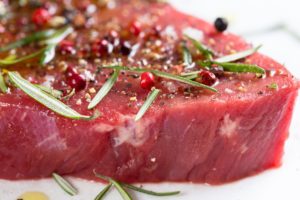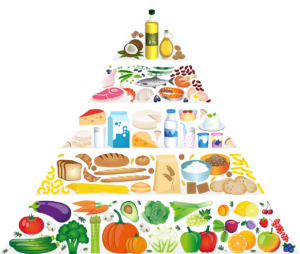6 Most Common Nutritional Mistakes in Endometriosis
The right diet for endometriosis can relieve symptoms and provide increased well-being. The “wrong” diet, on the other hand, promotes pain and inflammation and negatively affects endometriosis. But what is “wrong” and what is “right”? And is it even possible to always say for sure? Even though there are still big gaps in research and the right diet for endometriosis is always individual – there are some things you should avoid!
We show you the 6 most common mistakes in endometriosis nutrition!
1. Fast Food und industriell hergestellte Lebensmittel essen
The conventional understanding is that snacks, industrially processed foods, fast food, and convenience items are synonymous with unhealthiness. However, what specifically makes these choices detrimental to well-being? The culprits are trans fatty acids, which a single study indicated could escalate endometriosis risk by 48%. Notably, these fatty acids can exacerbate inflammation by up to 40%, imperil the immune system’s functionality, disrupt intercellular communication in the brain, potentially leading to depression and Alzheimer’s disease, and even bolster the growth of endometriosis lesions [6].
Trans fatty acids emerge during the industrial creation of hydrogenated fats (referred to as “hydrogenated fats” or “partially hydrogenated fats” and “vegetable oil, (partially) hydrogenated”), a process also occurring during the industrial deodorization of vegetable oils to nullify taste and scent, as well as during deep-frying – this includes your own kitchen. Conceivably, trans fatty acids could be present in all industrially manufactured foods like ready-to-eat meals, snacks (such as cookies and mass-produced baked goods), and fried items (like chips and potato chips).
Strive to transform snacks, convenience items, and fast food into rare indulgences. Opt instead to cook with fresh, high-quality ingredients, utilizing plant-based oils, and create your meals from scratch.
2. Consuming Foods Rich in Histamine
Histamine, a natural signaling molecule, can be released by the body itself and is generated within foods during the maturation processes. This compound serves as an inflammation accelerator [9], facilitating processes such as tissue swelling and heightened blood circulation. Moreover, histamine exerts influence on nerve activity, amplifying the perception of pain.
Histamine is also involved in the production of the hormone estrogen, which is responsible for the uterus sometimes contracting painfully. Thus, histamine is also involved in increasing pain during menstruation.
Considering this, it’s advisable to minimize the consumption of the following histamine-rich foods: sausages, aged and firm cheeses, smoked fish, alcoholic beverages, soy sauce, fish sauce, wine vinegar, yeast extracts, flavor enhancers, and fermented edibles.
3. Eating Red Meat
While adopting a vegan diet isn’t mandatory, it’s noteworthy that consuming meat can escalate pain and inflammation. However, not all meat varieties yield equal detrimental effects. A comprehensive study involving over 100,000 women [2] unveiled that those consuming more than two servings of red meat daily exhibited a staggering 56% heightened risk of developing endometriosis, in contrast to women who consumed red meat less than once a week.
Moreover, the consumption of red meat and processed meats significantly impacts specific sex hormones in relation to endometriosis. The intake of red meat amplifies endometrial growth by elevating estrogen levels, augments uterine blood flow, fosters inflammation, intensifies pain, and affects blood clotting. Red meat decidedly doesn’t bode well for endometriosis management. In contrast, there’s no concrete evidence suggesting that white meat poses the same extent of harm.
4. Giving up Sea Fish
In the context of endometriosis, a rational approach involves minimizing the consumption of red meat and various other animal-derived foods—yet, this principle does not extend to sea fish. This is because essential omega-3 fatty acids, EPA and DHA, critical for health, can solely be obtained from fatty sea fish or red algae. Significantly, these omega-3 fatty acids hold the potential to impede the growth of endometriosis lesions. Substantiating this, a separate study revealed that increased intake of these omega-3 fatty acids (paired with vitamin B) can alleviate pain as well. In simpler terms, a higher dietary intake of omega-3 fatty acids corresponds to reduced inflammation and pain arising from endometriosis lesions. Thus, there is a compelling rationale to incorporate fish (or red algae) into your diet on a consistent basis. [1]
5. Excluding an Excessive Number of Foods from your Diet
In the realm of the internet, a plethora of well-intentioned suggestions circulate, often outlining an extensive list of “should not eat” foods to mitigate endometriosis symptoms. Adhering to all such recommendations could inadvertently result in excluding numerous foods from your diet, potentially leading to malnutrition and further discomfort, negatively impacting your health. While it’s true that steering clear of certain foods, like red meat, can offer relief, a fair share of these “tips” might lack a scientific foundation. For instance, there is not a single study corroborating the idea that consuming dairy products hastens the growth of endometriosis lesions [3]. Conversely, low-fat dairy products have exhibited the potential in alleviating pain, attributed to their richness in essential minerals like calcium and magnesium [7]. Thus, when considering eliminating certain foods, it is prudent to do so from a medical perspective, rather than merely due to online hearsay. Additionally, personal tolerance to specific foods plays a role; always be attuned to how you feel after consumption, potentially aided by keeping a food diary.
6. Taking Vitamin Tablets
Certain vitamins, minerals, and phytochemicals can indeed contribute to alleviating the symptoms of endometriosis and, at times, even impede or decelerate the progression and growth of endometriosis lesions. Notable examples encompass antioxidants like vitamins A, C, and E, as well as minerals like calcium and magnesium. Secondary plant compounds, such as phytoestrogens or resveratrol, also merit mention. Given these potential benefits, the notion of consuming these through dietary supplements might appear appealing.
Regrettably, this approach is not advisable. Even with seemingly innocuous over-the-counter preparations, the risk of unintentional overdose is significant. The fact that excessive consumption of common dietary supplements can prove detrimental is often underappreciated. For instance, did you know that an excess of calcium could lead to cardiac arrhythmias or even a heart attack [4]? Or that an overdose of vitamin A might elevate intracranial pressure to a fatal extent [5], and excessive vitamin D intake could result in organ damage and mortality [8]?
Prominent institutions, including the Federal Institute for Risk Assessment (BfR), Stiftung Warentest, the Consumer Center, Öko Test, and the German Nutrition Society (DGE), concur that dietary supplements are wholly unnecessary.
Those who adhere to a balanced and nourishing diet (referring to point five: not excluding too many foods) do not necessitate dietary supplements. In fact, such supplements can even pose health risks. Instead, prioritize an ample intake of fruits and vegetables, fulfill your mineral requirements through sources like mineral water, and address your need for vitamin D through outdoor walks in the fresh air.
By incorporating the guidance we have provided on nutrition, it is entirely feasible to witness discernible improvements in your symptoms. Our endometriosis knowledge repository offers a wealth of information on potential therapies, including nutrition. And remember, savoring your meals should remain an integral part of the experience!
Wishing you every success and… bon appétit!
References
- (PDF) Endometriosis and dietary habits: Can diet make the difference? [Internet]. ResearchGate. [zitiert 2020 Mai 6]. Available at: https://www.researchgate.net/publication/325092608_Endometriosis_and_food_habits_Can_diet_make_the_difference
- YAMAMOTO A, HARRIS HR, VITONIS AF, CHAVARRO JE, MISSMER SA. Eine prospektive Kohortenstudie über Fleisch- und Fischkonsum und Endometrioserisiko. Am J Obstet Gynecol [Internet]. 2018 Aug [cited 2020 Apr 30];219(2):178.e1-178.e10. Available at: https://www.ncbi.nlm.nih.gov/pmc/articles/PMC6066416/.
- Snoj T, Majdič G. MECHANISMS IN ENDOCRINOLOGY: Estrogens in consumer milk: is there a risk to human reproductive health? European Journal of Endocrinology [Internet]. 2018 [cited 2020 May 28];R275-86. Available at: https://eje.bioscientifica.com/view/journals/eje/179/6/EJE-18-0591.xml.
- Reid IR, Birstow SM, Bolland MJ. Calcium and Cardiovascular Disease. Endocrinol Metab (Seoul). 2017 Sep;32(3):339-49.
- Olson JM, Ameer MA, Goyal A. Vitamin A Toxicity. In: StatPearls [Internet]. Treasure Island (FL): StatPearls Publishing; 2021 [zitiert 2021 May 24]. Available at: http://www.ncbi.nlm.nih.gov/books/NBK532916/
- Missmer SA, Chavarro JE, Malspeis S, Bertone-Johnson ER, Hornstein MD, Spiegelman D, et al. A prospective study of dietary fat consumption and endometriosis risk. Hum Reprod. 2010 Jun;25(6):1528-35.
- Harris HR, Chavarro JE, Malspeis S, Willett WC, Missmer SA. Dairy products, calcium, magnesium, and vitamin D intake, and endometriosis: a prospective cohort study. Am J Epidemiol [Internet]. 2013 Mar 1 [cited 2020 May 8];177(5):420-30. Available at: https://www.ncbi.nlm.nih.gov/pmc/articles/PMC3626048/
- Galior K, Grebe S, Singh R. Development of Vitamin D Toxicity from Overcorrection of Vitamin D Deficiency: A Review of Case Reports. Nutrients [Internet]. 2018 Jul 24 [cited 2021 May 24];10(8). Available at: https://www.ncbi.nlm.nih.gov/pmc/articles/PMC6115827/.
- Branco ACCC, Yoshikawa FSY, Pietrobon AJ, Sato MN. The role of histamine in modulating immune response and inflammation. Mediators Inflamm [Internet]. 2018 Aug 27 [cited 2020 Jun 1];2018. Available at: https://www.ncbi.nlm.nih.gov/pmc/articles/PMC6129797/.
- Finding the Perfect Nutritionist: A Step-by-Step Guide - 5. October 2023
- Does Monk’s Pepper Help with Endometriosis? - 5. October 2023
- A Brief Overview of Dietary Fats - 29. September 2023






